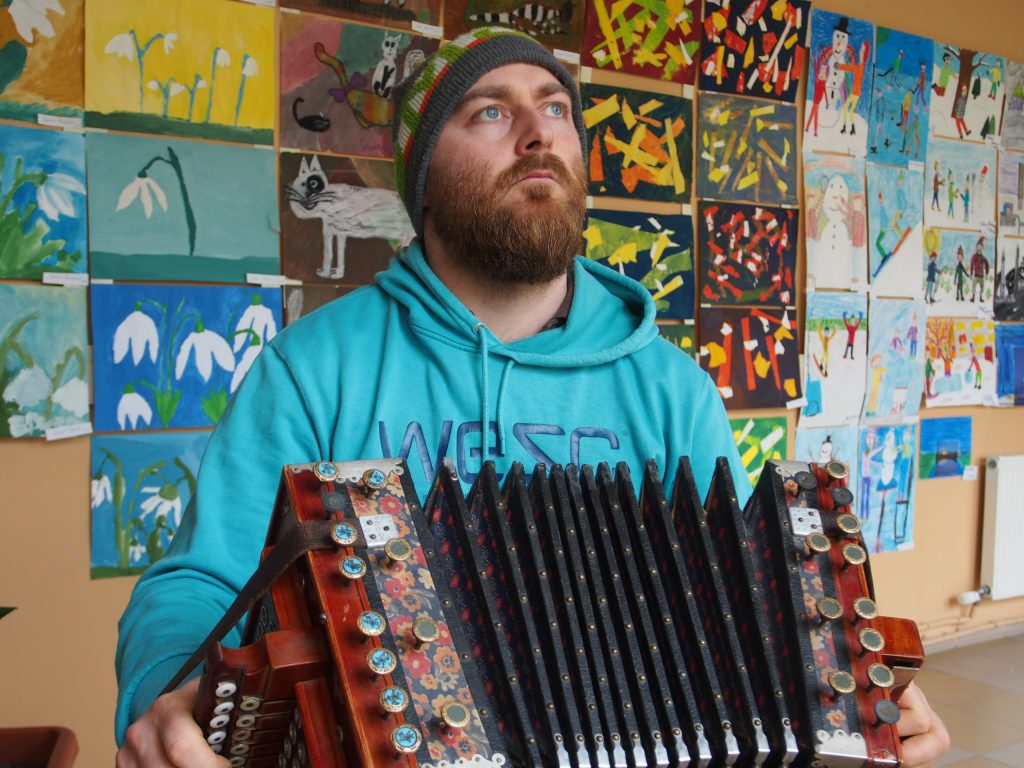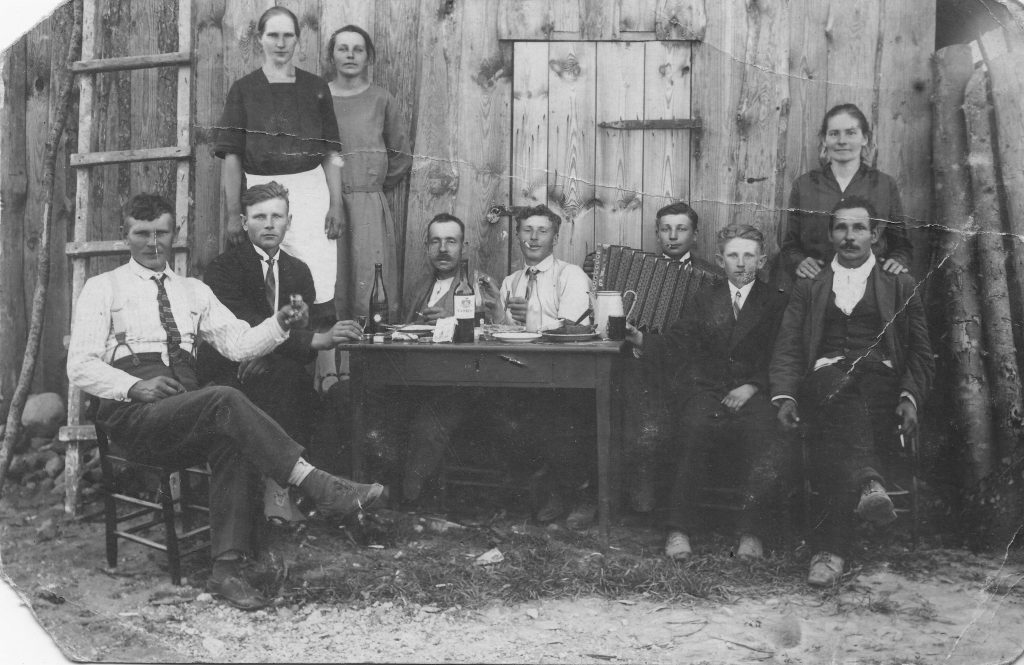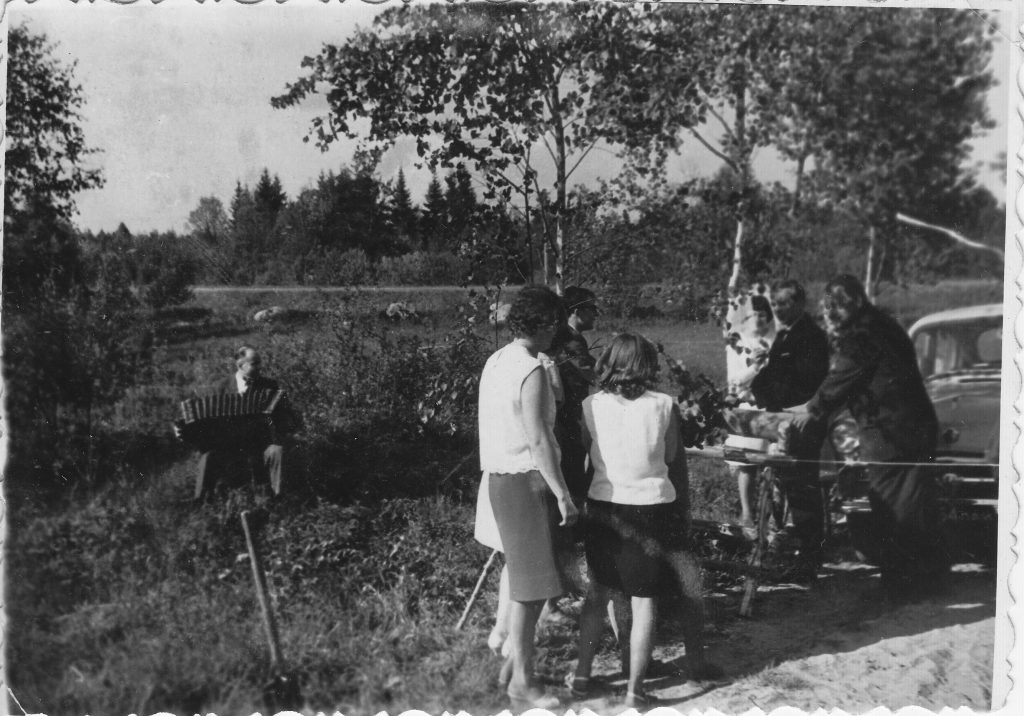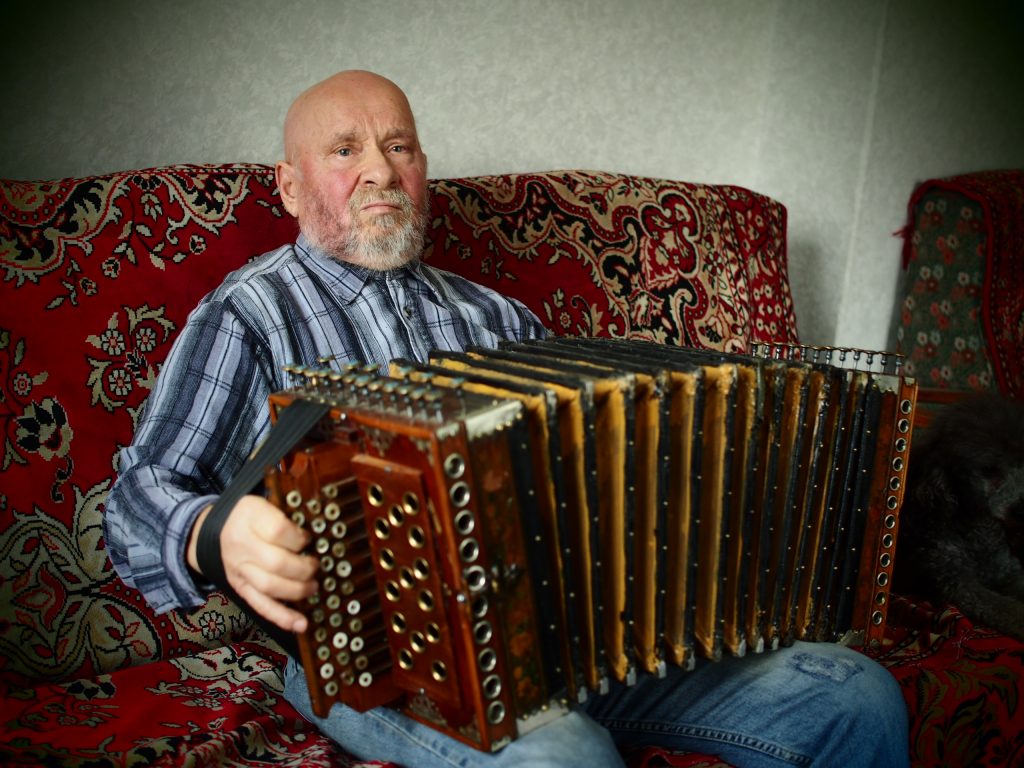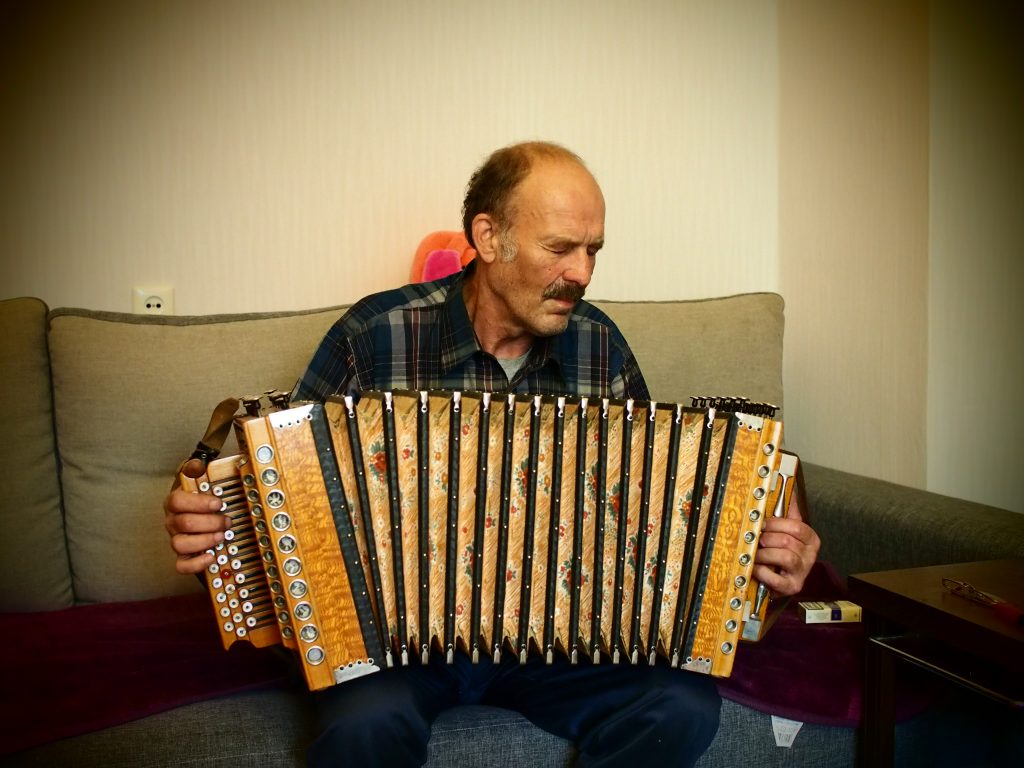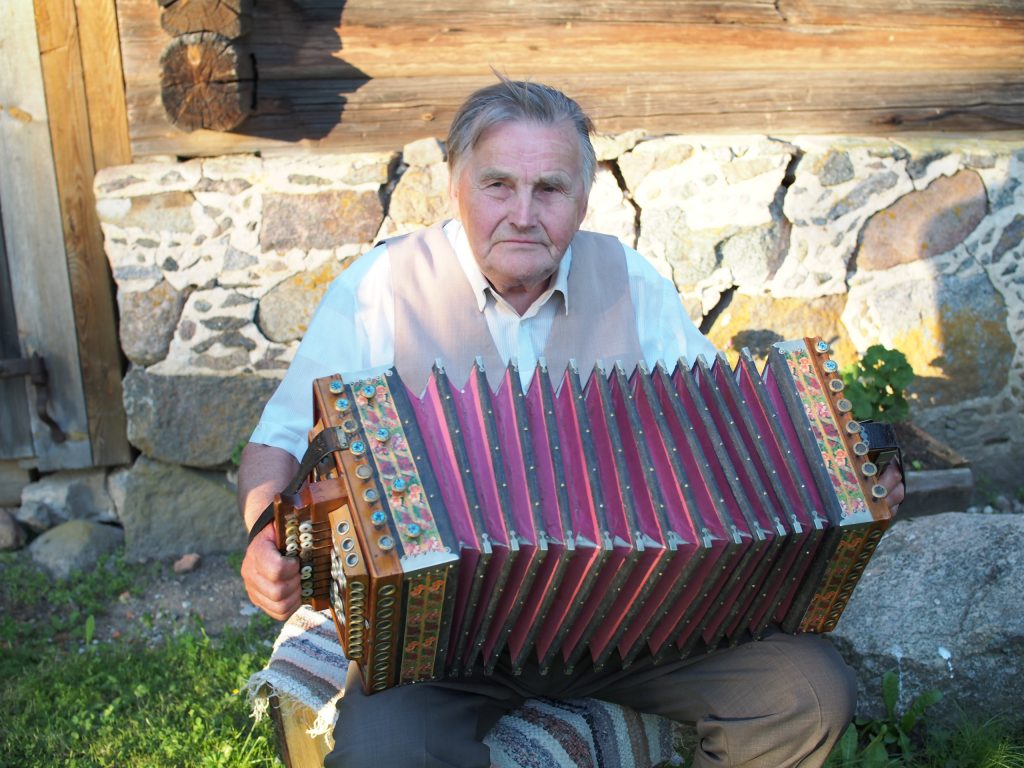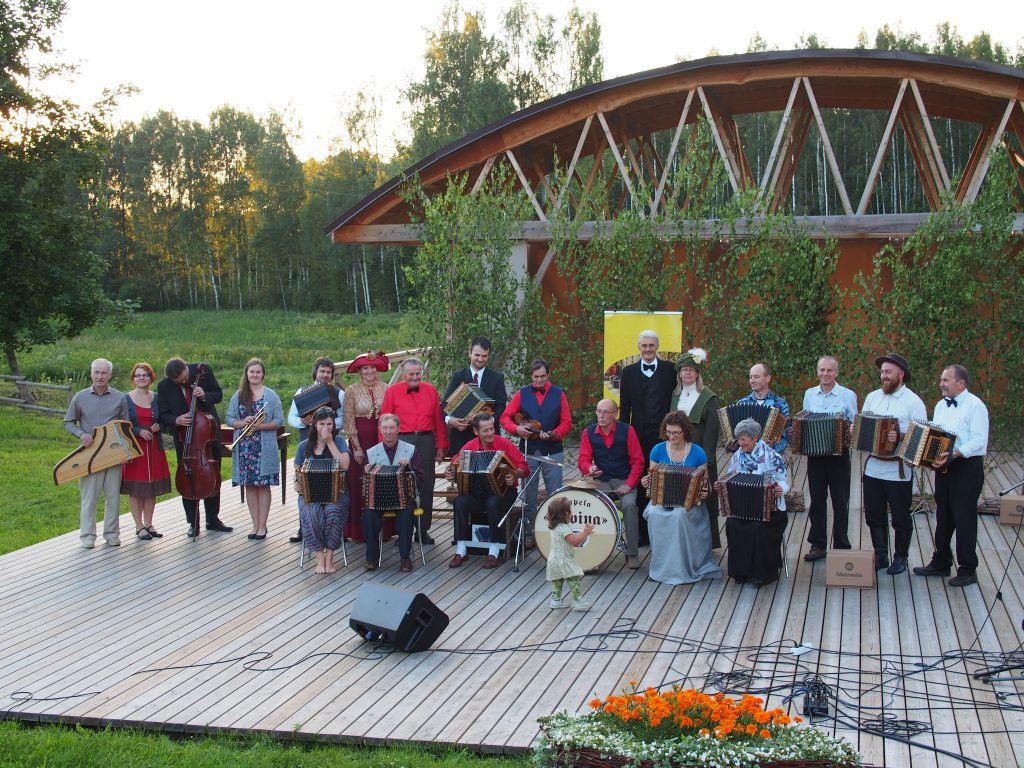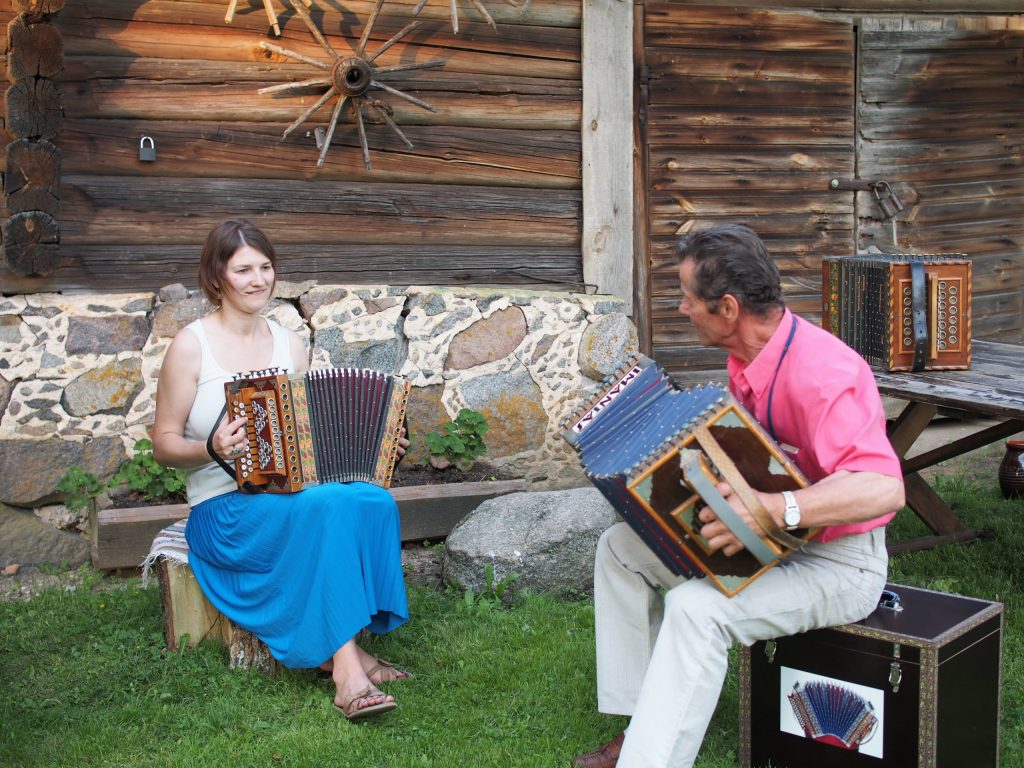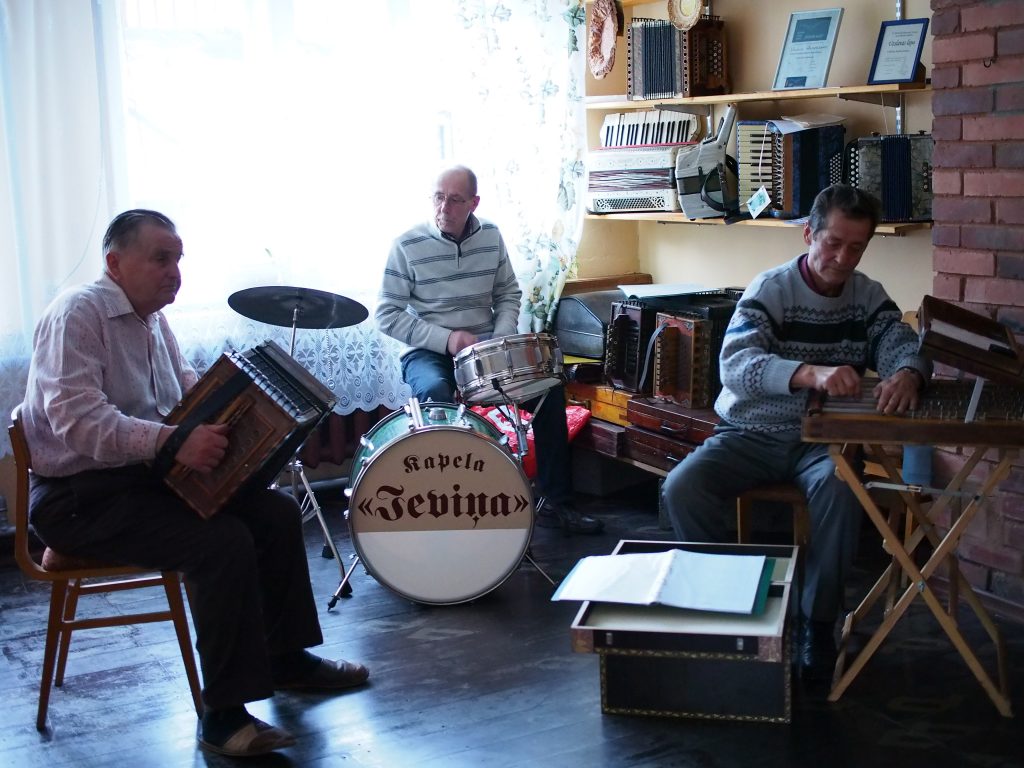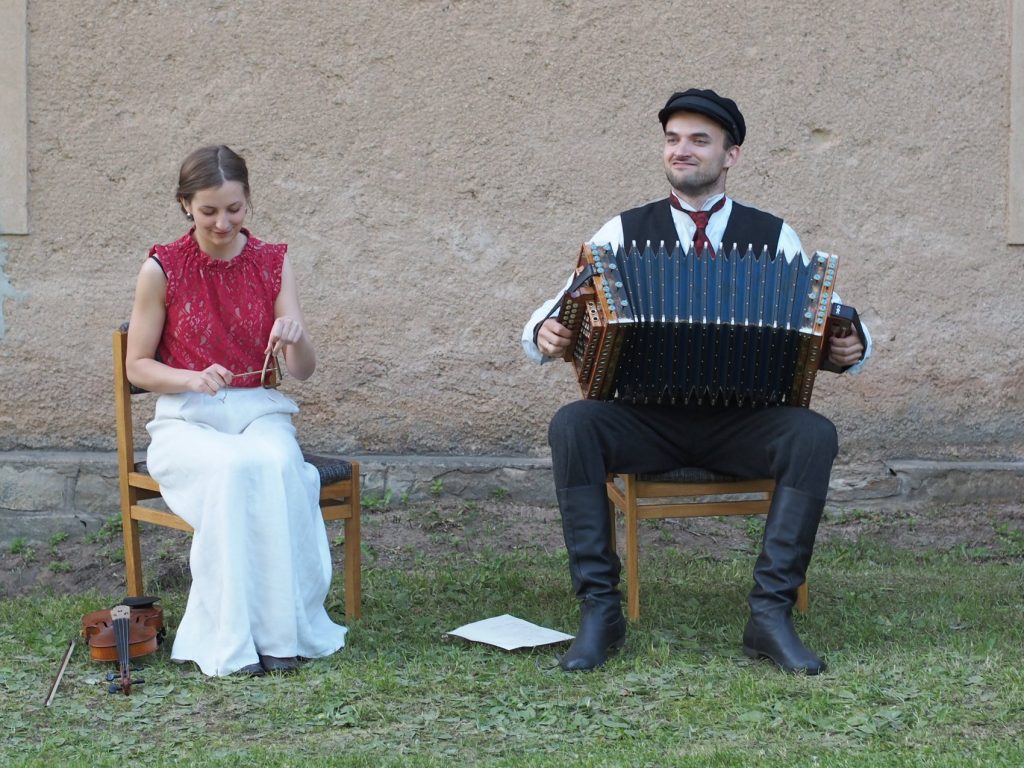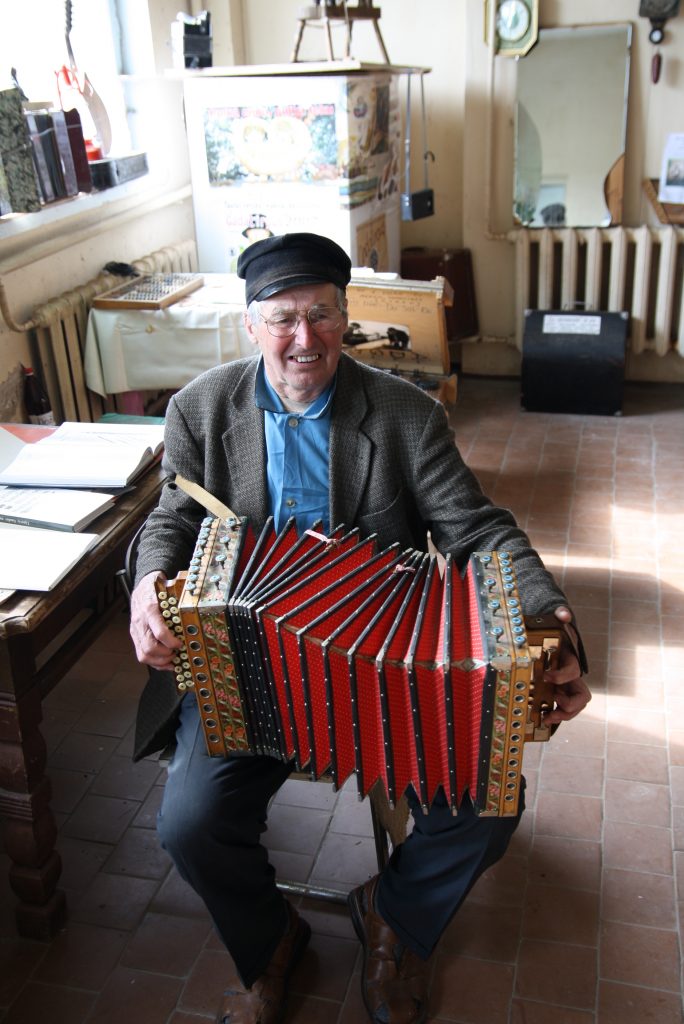Author:
Oskars Patjanko
Music/performing arts
Traditional craft skills
Title
The tradition of crafting and playing the Ieviņš type diatonic harmonica (2017)
Ieviņa ermoņikas, ieviņas, ieviņa, ieviņš, ermoņikas, ermoņika; also harmonika, garmoška, dūkas, Ieviņa dūkas (Smiltene area), dūdiņas, plēšiņas.
To play the ieviņa, to play the garmon, to build garmon, to repair garmon, to tune garmon.
Geography
Vidzeme and Riga. In rare cases, certain instruments can also be found outside the region.
There are several groups with connections to the Element. These include:
1. Passive tradition bearers: people who do not play the instrument themselves but are able to identify and appreciate the instrument. Most often these people had a relative in their childhood who played in the ieviņas or they have participated in events where the Ieviņš-type garmon was played.
2. Individuals who hold an instrument played by a relative and consider it an important family relic; also separate individuals who play the instrument actively and have inherited the performance skills in a traditional way.
3. Persons who have learned the instrument performance in the last 10 years individually or in the courses organised by the association “Skaņumāja” and form a community which communicates amongst each other and participates in gatherings.
Importance in Community Life
The Ieviņš-type harmnonica or "ieviņas" is a type of harmonica characteristic of the Vidzeme area that was a pivotal musical instrument in early 20th century get-togethers and dances.
It have a particular place in the cultural traditions of the region, as there were practically no other types of instruments in the area, and the instruments of such construction are not found elsewhere.
Activities
They have a very rich, plump sound, which is achieved by an unusually large number of reeds or "voices".
For a typical Ieviņš-type garmon, each sound is created by six reeds that have been tuned in octaves, with a slight offset forming the characteristic vibrating tone.
The instruments built by local masters have a relatively archaic structure with bellows glued on wooden frames, as well as a special accompaniment keyboard mechanism that allows very easy playing of the accompaniment in a broad mix of chords. The instrument has an unusually ornate appearance with colourful floral motif stickers, decorative register switches and large quantities of decorative metal ornaments.
They were played in both at home and for the enjoyment of the family, as well as performing for the public—solo or with other folk music group instruments (violins, mandolins, zithers, bass) in dance music events, weddings, confirmations and other family celebrations, markets, collective work gatherings and theatre shows.
In the second half of the 20 th century, as the cultural environment changed, they mostly became the musical tool of the home, as well as participants in rural music band performances.
Inheritance and transmission
The instrument performance is not very complex, most of the tradition inheritors have learned it by themselves, watching other musicians play and trying to play familiar melodies.
Nowadays, the biggest difficulty of people learning to play is the non-linear note arrangement – similar to other bisonoric bellow instruments – the entire diatonic sound row can be played by changing the direction of the bellow movement.
Currently, new people interested in learning the instrument performance are usually associated with the folklore movement; they mainly study folk dance melodies.
Today, the instrument is most often heard in concerts.
History
The first harmonicas in Latvia was introduced in the 1840s from Germany and Austria, and due to its unique qualities (it is a light, loud, convenient, easy-to-wear and easy-to-use instrument) quickly became one of the most important dance musical instruments among the Latvian peasants and city-dwellers.
At the end of the 19th century, various types of garmons were known in the territory of Latvia, among them also the organ-garmon that was popular in Germany at the time: an instrument with many register switches and a rich timbral sound, which comes from the large number of simultaneously-resounding reeds.
This was the instrument that was taken as the prototype based on which Vidzeme artisans began to make their own garmons, learning this skill from each other.
At the beginning of the 20th century, Augusts Ieviņš became the most successful and popular builder of garmons, and he is likely the person from whom the instrument acquired the name "Ieviņas". But he was not the only one: many other professional instrument builders were active in Riga and major cities around Vidzeme.
At least 10 builders of the instrument are known currently. It has also been a common practice for musicians to make their own instruments.
During the first half of the 20th century, the Ieviņš-type garmon was an indispensable instrument of dance music throughout Vidzeme. They were played in both solo and ensemble, most often with one or two violins, zithers and drums.
As a result of its colorful appearance and substantial price, it was also a status symbol of the player – as opposed to violins, which could also be purchased by the less wealthy members of society.
In the second half of the 20th century, keyboard accordions began to take place of the Ieviņš-type garmon in public events, later switching to guitars and synthesizers. The reasons for this were the change in the trends of popular music, also the very dismissive attitude by the official culture establishment, as well as the lack of instrument builders.
However, the musicians who had learned and played the Ieviņš-type garmon during their childhood continued to play privately and, in some cases, in semi-professional musical ensembles.
Nowadays, a new role has been attached to the Ieviņš-type garmon: the role of cultural identity.
They are used to symbolize the Latvian folk music in both films and pictures on the covers of books and musical disks, as well as event posters, although the instruments themselves are not played in these events and their sound is not heard.
Sometimes they are also used to help create an ethnographic and folk-inspired interior in homes, pubs and public institutions.
Also, musicians who play the Ieviņš-type garmon often use them not as a basic instrument for musical performance, but as a special element of the show - a display of a unique tradition.
Additional Information
The Ieviņš-type harmonica performance is related to playing music in everyday life, the playing in traditional music groups, the organisation of formal and informal dance evenings.
The tradition of Ieviņš-type garmon play is closely linked to the mastery of repertoire of traditional dances and songs.
It is also important for the musician to know the traditions of the celebrations of the Community, and an important skill is the ability to use music performance as a communication tool: to choose material suitable for the situation and to be able to emotionally influence the audience with its performances.
The building of harmonicas is linked to the skills of carpentry and local crafts skills, including the tradition of domestic production.
The masters who produced the instruments themselves participated in all stages of the preparation of the instrument, including the manufacture of reeds.
There is evidence that the musicians often made and repaired the harmonicas themselves.
Masters
The masters of harmonica performance, who have inherited the playing skill or knowledge of it in a traditional way.
1. Valdis Andersons (b. 1936, Tūja), head of the rural music group “Ieviņa”,
2. Juris Golvers (b. 1946, Vainiži parish),
3. Juris Saukums (b. 1941, Mazsalaca),
4. Juris Dūmiņš (b. 1948, Palsmane),
5. Aivars Katajs-Paeglis (b. 1954, Alūksne).
Masters who have learned the repair of garmons and perform repair work actively.
Raitis Sondors,
Juris Golvers.
Institutions and Organizations
The association “Skaņumāja”, prepared and promotes the ICH entry application, provides educational and promotion measures.
The association “IMUS”, provides the repair and manufacture of instruments as well as promotion activities
Association “Ķekavas muzikanti”, organizes promotional events
Strengthening the Tradition
Mutually complementary element conservation activities take several directions –
• Promotion of the tradition, including through practical use in concerts.
• The instrument can be viewed and is demonstrated in the “Skaņumāja” exhibition of traditional instruments.
• The theme 2017 International Folk Music Festival "Dzīvā mūzika" was harmonica performance, focusing on local traditions, including the performance of Ieviņš-type harmonica; several concerts and awareness lectures/demonstrations were held.
• The 2018 festival Baltica storyteller and musician concert featured the musician groups “Ieviņa” and “Brička”
• 2018, 2019 “Early and rare musical instrument player gathering” in Liepupe parish with the participation of the Ieviņš-type garmon players.
• 2020 television stories on ReTv and LTV “Latvian Heart Song”.
• 2020 concert of Ieviņš-type garmons in the Amata municipality Ruķeļi homestead organized by the association Lauska
• As a part of the 2020 video concert cycle “Pearls in the pocket”, the film “Ieviņš-type garmon” was created with the performances of several players and groups https://www.muzikanti.lv/ievina-ermonica.
• 2021 publication by L. Līcīte “Fair Lady Ieviņa and three Vidzemians” in the magazine Mūzikas Saule.
• Along with changing organizers (V.Andersons, Kekava Musician Society), up to 2021 the 3rd, 4th, and 5th Ieviņš-type garmon player gatherings took place.
• scenes with the Ieviņš garmon playing are included in cinema films of national importance – “Dvēseļu Putenis” (2018) and “Zeme, kas dzied” (2022).
• A number of music groups and individual players showcase the playing of the Ieviņš-type harmonica at various events – the folk music group Brička (more than 40 events, including abroad), the rural music band “Ieviņa” (around 10 events annually), Oskars Patjanko, Ilona Dzērve-Tāluta.
Research and documentation. In the Skaņumāja video concert cycle “Pērles kabatā. Bubyns” several older generation and new players are shown (Valdis Andersons, Juris Golvers, Oskars Patjanko, Līga Broduža). In 2021, the Kekava Musician Society interviewed granddaughter of A. Ieviņš Brigita Krastiņa on the stories of her memories. O. Patjanko has documented Juris Dūmiņš's repertoire, as well as gathered the information of other players.
Teaching the instrument performance. The training opportunity is provided by the “Skaņumājas” traditional instrument performance courses (in 2017, 4 participants took the course), as well as the master classes “Let's play in Skaņumāja” (2019-2021). In 2018, a self-teaching textbook of the Ieviņš-type harmonica was published in Latvian and English, downloadable free of charge on the website musikanti.lv.
The provision/manufacture of instruments. The repair of the instruments is carried out by Oskars Patjanko and the association “IMUS”, Master Arnis Ābelīte. “IMUS” has developed techniques for the complete manufacture of all parts of the instrument. By 2022, 2 new instruments have been built; a complete renovation of 6 instruments and repair and tuning of 7 instruments has been carried out. For the provision of training activities, the association “Skaņumāja” has acquired 2 instruments.
Awareness of the value of ICH and the understanding of the role of the instrument in Latvian musical traditions in society has increased. The availability of quality instruments (but also the market prices of historical instruments) has increased. The number of active players increases extremely slowly – 2-3 persons in the reporting period. Accordingly, the tradition is still considered to be severely endangered.
Current activities have been implemented mainly through support of the State Culture Capital Fundation (music activities, playng courses, documenting, other promotion measures), EU education programmes for Erasmus + (self-training book project), financing of the National Culture Centre (education and music activities), local government support (support for the development of music events), contributions of private stakeholders (acquisition of instruments, training costs)
Continuity/Development
All created resources for the promotion of this value will be maintained - web pages with informative, educational and artistic materials, the exposition of "Skaņumāja" instruments.
The opportunity for potential interested parties to get to know Ieviņš-type harmonica playing will be offered for visitors of the festival Baltica 2022. The Ķekava Musician Society intends to issue an album of the “Brička” ensemble.
There are also plans to continue organizing the get-togethers of the Ieviņš-type garmon players; organizers will use the possibilities of attracting relevant music groups and players, informing the public and participants in other music and traditional cultural events. Valdis Andersons, an enthusiast of the Ieviņš-type harmonica, intends to create a publicly available instrument exhibition which would also include the Ieviņš-type harmnonica in collaboration with the Limbazi Museum. O. Patjanko will continue to document the repertoire of the players.
Regular provision of educational opportunities, training courses in courses and masters will continue. An Ieviņš-type harmonica playing group is planned to be formed as part of the “Skaņumāja” instrument learning courses in autumn 2022.
Include the element as one of the skills to be acquired as part of the planned traditional instrument-playing program in professional culture education institutions.
The association “IMUS” intends to ensure the repair of instruments, to produce 2-4 new instruments per year, as well as to improve technological solutions to reduce costs.
The “Skaņumāja” organisation will monitor the dynamics of the use of the instrument, the identification and documentation of modern players, and the identification and collection of historical evidence, photographs, instruments etc.
The objectives of the measures are the ICH values – the preservation, protection and promotion of the Ieviņš-type harmonica playing traditions. Ensure the sufficient availability of high quality information, the representation of the tradition tradition in musical and cultural events, the provision of inheritance through education, maintaining the number of experts required for stable maintenance and distribution, and the availability of instruments.
Threats to the Tradition
The tradition of Ieviņš-type harmonica is significantly endangered for a number of reasons.
1. Lack of instruments that are high-quality and suitable for modern-day collective music playing.
Most of the historical instruments have been poorly preserved and are waiting for repair, which is currently only partially possible in Latvia – not all parts can be manufactured or purchased. There are already potential new players who do not have the ability to obtain a sufficiently good instrument for playing. In addition, the tuning of almost all of the historical instruments is different from the standard tuning practices used today, so it is problematic to use them for musical purposes along with other instruments.
2. The production of new instruments is very expensive.
Ieviņš-type garmon contains a lot of elements that need to be hand made; it is a very time-consuming process. Similarly, there are high costs for specially designed components that are not practical to make by hand (reeds, metal fittings, buttons, etc.).
Although there currently are masters with the necessary knowledge in Latvia, the production of a new instrument would require large financial investments (for comparison – the price of the related design Estonian instrument is up to 4000 euros).
The purchase of such an instrument can be afforded by few musicians. The support of understanding local governments, sponsors, patrons is expected to be very important for further successful development.
3. Traditional instrumental music has low public demand.
The traditional repertoire of the Ieviņš-type harmonica (which, like other instruments, has developed through the interactions of the music trends of its time and the technical possibilities of the instrument) is formed of the newest layer of folklore, songs ("schlagers") and dance, and the popular music of the first half of the century.
The demand for such music is not particularly big, while folklore ensembles and dance clubs have created their dance music repertoire, which also includes many of the dances and melodies that have recently been created or borrowed from other places, which are not easy to play on the Ieviņš-type garmon due to the technical features of the instrument. The updating of the instrument playing technique will be carried out along with the promotion of appropriate repertoire and collective music playing forms.
Applicant
Association "Skaņumāja", reg. no. 40008106801
Photo Gallery
Audio Materials
Video Materials
Publications
Saint Kēvičs, b. Jāņi - Summer sunshine. Riga: science, 1994
Tihovska, I. Winter sunshine music. Kraj. A practical Christmas book. Riga: Centre for Culture and Intangible Heritage, 2009
Patjanko, O. Ieviņas, Rīga: Lauska, 2014
Websites
http://muzikanti.lv/lv/projekti/skanu-maja/ - information on the project and video manuals in the construction and play of the Ieviņš-type harmonica
http://ermonikas.blogspot.com/ - Oskars Patjanko's blog on garmons in Latvia

